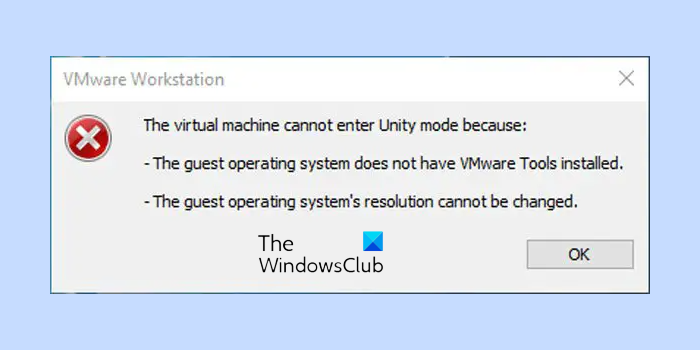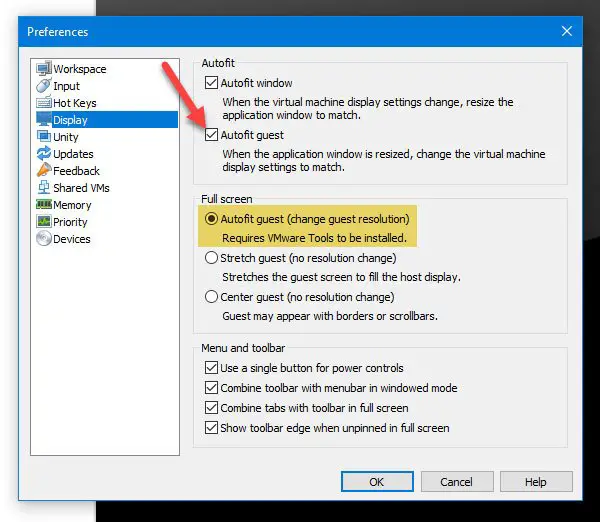If when you are trying to open the Unity mode in VMware Workstation, you see this message, then this post will help you troubleshoot this issue:
The virtual machine cannot enter Unity mode because:
- The guest operating system does not have VMware Tools installed or
- The guest operating system’s resolution cannot be changed.

What is Unity Mode in VMware Workstation?
The Unity mode of VMware helps you open an app of the virtual machine in your actual Windows installation. The Unity Mode has several benefits like it allows you to run the applications from different operating systems installed on your Host machine on your Host machine, it makes it easy to switch between the applications on different operating systems installed on the same Host machine, etc.
Let’s assume that you have developed an app and are testing it in the virtual machine – and suddenly you need to test something on the actual machine’s interface. At such moments, instead of moving the executable file from the virtual machine to the host machine and installing it, you can use Unity mode to perform the same but faster.
However, a user can fail to enter Unity mode because of several reasons. Some of the most common causes are lack of VMware Tools and fixed resolution. These suggestions may help you bypass this error within moments.
VMware Workstation cannot enter Unity mode
To fix the Virtual machine cannot enter Unity mode error on the VMware workstation, use the following solutions:
- Install VMware Tools
- Set Autofit guest
- Did you increase the video resolution manually?
Let’s see all these fixes in detail.
1] Install VMware Tools
VMware Tools is the most critical component when you are entering Unity mode. Without this, you may not be able to use this functionality of VMware Workstation. As this utility is responsible for graphics performance, you need to install VMware Tools first – if you haven’t done already. For that, you can log into the guest OS, press Win + R, type this-
D:\setup.exe
And hit the Enter button.
If you have already installed it earlier, but still you still see this error message, you have to wait for a couple of seconds before clicking the button. Once the virtual machine is turned on, you need to wait until the VMware Tools get started. Although there is no specific time for waiting, you can spend at least 15 seconds after logging into your machine.
2] Set Autofit guest
By default, if you resize the resolution of a virtual machine, the OS’s resolution gets changed automatically. However, some options might block it automatically. If you have recently made some changes in the settings panel, here is what you need to verify.
Open the VMware app > Edit > Preferences and go to Display menu and make sure the Autofit guest option is selected under Full screen. If not, do select it and save your change.

Now, restart your virtual machine, wait for a couple of seconds, and click the button to enter Unity mode.
3] Did you increase the video resolution manually?
VMware allows you to set a custom video resolution by changing the value of svga.autodetect to FALSE. By default, it is set to TRUE. To do so, you have to edit the .vmx file after shutting down the VMware virtual machine. If you have changed its value, you might have been experiencing this issue. Change it back to TRUE to fix this issue. This fix has worked for some users.
How do I enable Unity Mode in VMware?
Enabling the Unity Mode in VMware is easy. Click on the View menu on VMware and then select the Unity option. Alternatively, you can also enter the Unity Mode by clicking on its icon on the menu bar in VMware.
Also read: VMware Workstation Pro can’t run on Windows.
Hope it solves your issue!
Leave a Reply